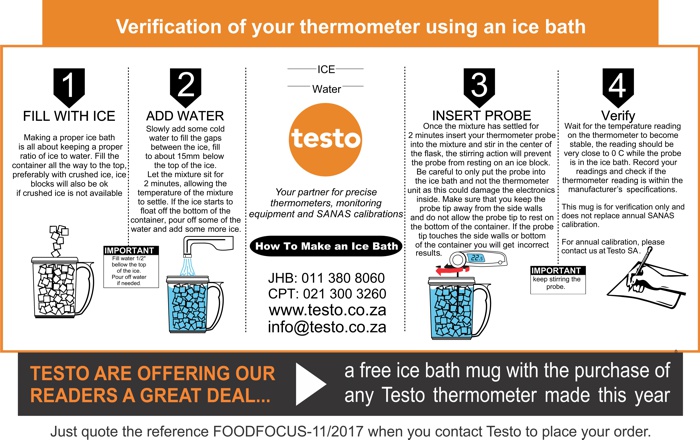Did you know you need to test your thermometer’s temperature? Seems a strange concept when the purpose of the instrument is to measure temperature, but the point is to verify that equipment is maintaining temperatures between regular calibrations. Even the best instruments may give readings that are in error.
Verification of your Thermometer
The general use of a thermometer is to verify temperatures of calibrated equipment such as chillers or incubators or even products. However, the thermometer itself should also be calibrated regularly by a SANAS accredited facility and should then undergo regular verification to be able to identify if it is “sick” or still accurate. Typical causes of a ‘sick thermometer’ include large mechanical shocks, large thermal shock, drift in the sensor or readout characteristics with time, or incorrect entry of calibration coefficients. Obviously the more you use it the more likely it is to get sick from the causes listed above.
These verification measurements are part of preventative maintenance measures and may also be used to justify increasing the period between regular calibrations of the equipment, thereby reducing maintenance and calibration costs.
An easy method of verifying almost any thermometer is to use it to measure a known temperature. In order to know a temperature accurately it must be measured and if this is the only thermometer you have how will you measure the unknown temperature with the thermometer that is being verified?
So, we need another method of producing a known temperature and the easiest to produce are the freezing and boiling points of water. Technically speaking we use the melting point of ice, which for our purposes is 0.0 °C and to achieve it we will need an ice bath.
How to verify using an ice bath
Take a flask and fill it with crushed or shaved ice, then add a little water to make slush. Stir the slush and wait a few minutes. By definition, if ice and water are present, then the ice must be melting, and we will have 0.0 °C until all the ice has melted. However, to ensure accuracy, it is best to use distilled water for the ice and water, and to not contaminate the slush with dirty fingers and probes. Insert your thermometer probe into the ice bath and wait for the reading to settle. The displayed value will show you the error of your thermometer at 0.0 °C. in other words if the reading is above 0.0 °C (or below for that matter) there is a factor you must take into account when you use the thermometer for any other temperature reading. To make it easy for yourself, you should rather have the thermometer re-calibrated to avoid any silly arithmetic error.
Step by step guide to using an ice bath
How to verify a thermometer using boiling water
According to the National Institute of Standards and Technology in the USA, if the digital thermometer is used over a narrow temperature range (e.g., –50 °C to 100 °C), a single-point check at the ice melting point (0 °C) or at an ambient temperature is a sufficient method of performance verification. (For those detail driven people who can’t help themselves then an additional temperature point that may be used is that of boiling water.
Simply boil a suitable amount of water in a kettle and measure the temperature. Your thermometer should read 100.0 °C IF, and you’ll notice that this is a big IF, and only IF you are at sea level. Actually, more specifically if the ambient air pressure is at 1013 mBar. So, using the boiling point of water as a known temperature is a little more difficult as the temperature value may change at sea level by up to 3 °C. At higher altitudes such as Johannesburg or Pretoria, the boiling point of water is only 95 ° but it is generally stable to within 0.5 °C so it is more useful.)
As with any verification checks, it is important to record your values so that any errors can be accounted for during actual measurements. Records also keep auditors happy and will assist you in making sure you can spot a sick thermometer.
Note:
(For the purposes of this article, the term “thermometer” will refer to a digital device and not to a liquid-in-glass thermometer.)
References
http://www.intercal.co.za/docs/The_Use_of_Hand_Held_Digital_Thermometer_in_an_Analytical_Laboratory.pdf
https://www.nist.gov/pml/mercury-thermometer-alternatives-verification-methods-alternative-thermometers




